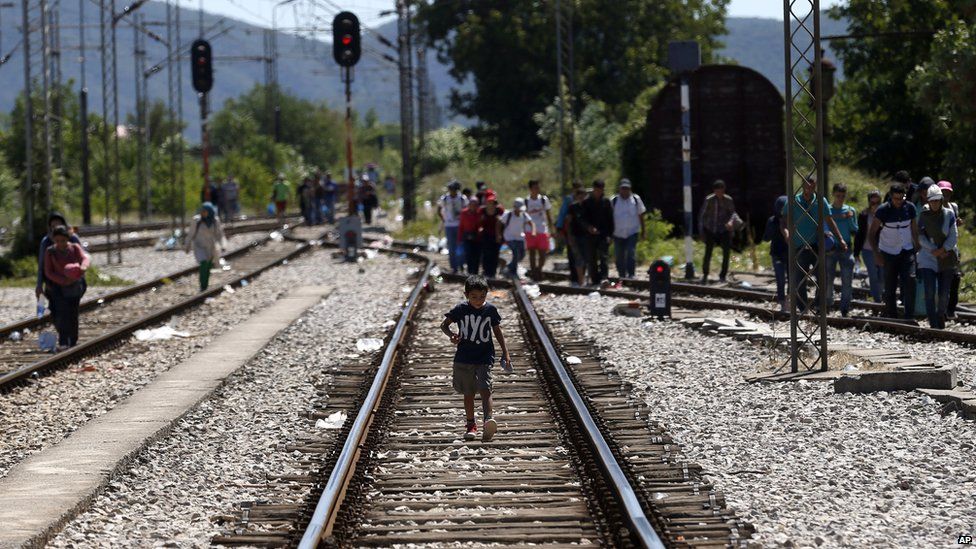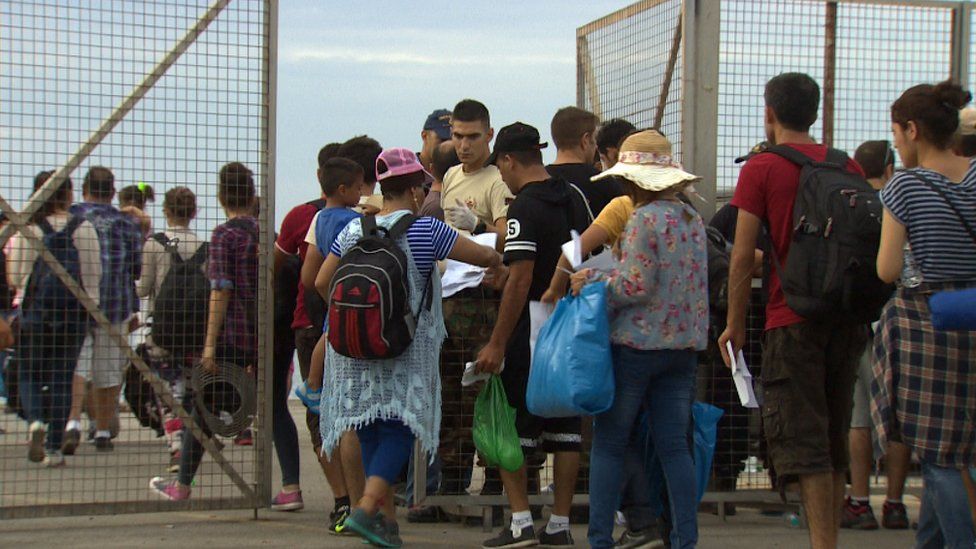BAGHDAD – Europe's migration debate has taken a disturbing turn.
It began with the creation of the catch-all concept (a legal freak) of a "migrant," which obscures the difference, central to the law, between economic and political migration, between people escaping poverty and those driven from their homes by war. Unlike economic migrants, those fleeing oppression, terror, and massacre have an inalienable right to asylum, which entails an unconditional obligation by the international community to provide shelter.
Even when the distinction is acknowledged, it is often as part of another sleight of hand, an attempt to convince credulous minds that the men, women, and children who paid thousands of dollars to travel on one of the rickety boats washing up on the islands of Lampedusa or Kos are economic migrants. The reality, however, is that 80% of these people are refugees, attempting to escape despotism, terror, and religious extremism in countries like Syria, Eritrea, and Afghanistan. That is why international law requires that the cases of asylum-seekers are examined not in bulk, but one by one.
And even when that is accepted, when the sheer number of people clamoring to get to Europe's shores makes it all but impossible to deny the barbarity driving them to flee, a third smokescreen goes up. Some, including Russian Foreign Minister Sergei Lavrov, claim that the conflicts generating these refugees rage only in Arab countries that are being bombed by the West.
Here again, the figures do not lie. The top source of refugees is Syria, where the international community has refused to conduct the kinds of military operations required by the "responsibility to protect" – even though international law demands intervention when a mad despot, having killed 240,000 of his people, undertakes to empty his country. The West also is not bombing Eritrea, another major source of refugees.
Yet another damaging myth, perpetuated by shocking images of refugees swarming through border fences or attempting to climb onto trains in Calais, is that "Fortress Europe" is under assault by waves of barbarians. This is wrong on two levels.
First, Europe is far from being the migrants' primary destination. Nearly two million refugees from Syria alone have headed to Turkey, and one million have fled to Lebanon, whose population amounts to just 3.5 million. Jordan, with a population of 6.5 million, has taken in nearly 700,000. Meanwhile, Europe, in a display of united selfishness, has scuttled a plan to relocate a mere 40,000 asylum-seekers from their cities of refuge in Italy and Greece.
Second, the minority who do choose Germany, France, Scandinavia, the United Kingdom, or Hungary are not enemies who have come to destroy us or even to sponge off of European taxpayers. They are applicants for freedom, lovers of our promised land, our social model, and our values. They are people who cry out "Europe! Europe!" the way millions of Europeans, arriving a century ago on Ellis Island, learned to sing "America the Beautiful."
Then there is the ugly rumor that this imaginary assault has been clandestinely orchestrated by the strategists of a "great replacement," with foreigners supplanting native Europeans, or, worse, by agents of an international jihad, in which today's migrants are tomorrow's terrorists on bullet trains. It should go without saying that this is nonsense.
Taken together, these distortions and delusions have had serious consequences. For starters, the Mediterranean Sea has been all but abandoned to human smugglers. The Mare Nostrum is gradually becoming the kind of vast and watery mass grave described by a faraway poet. Some 2,350 people have drowned already this year.
But, for most Europeans, these people are little more than statistics, just as the women and men who have survived the journey remain unidentified and indistinguishable, a threatening anonymous mass. Our society of the spectacle, normally so quick to manufacture an instant celebrity to serve as the "face" of the crisis du jour (anything from swine flu to a truckers' strike), has not taken an interest in the fate of a single one of the "migrants."
These individuals – whose course to Europe resembles that of the Phoenician Princess Europa, who arrived from Tyre on Zeus's back several millennia ago – are being wholly rejected; indeed, walls are being constructed to keep them out. The result is another group of people being denied basic rights. Such people, as Hannah Arendt once observed, will ultimately come to see in the commission of a crime their only path into the world of law and of those who enjoy the rights the law confers.
Europe, harassed by its xenophobes and consumed by self-doubt, has turned its back on its values. Indeed, it has forgotten what it is. The bell tolls not only for the migrants, but also for a Europe whose humanistic patrimony is crumbling before our very eyes.
Source: The Price of European Indifference

 Ljubljana is old. Ancient, even. This 2,000-year-old Roman outpost is now an unbelievably green city, compact and traveler-friendly and filled with life. Find the cobbled streets, castles and squares you would expect, sure, but don't be surprised to uncover a buzzing nightlife (locals like to party hard) as well as one of Europe's most progressive modern-art scenes.
Ljubljana is old. Ancient, even. This 2,000-year-old Roman outpost is now an unbelievably green city, compact and traveler-friendly and filled with life. Find the cobbled streets, castles and squares you would expect, sure, but don't be surprised to uncover a buzzing nightlife (locals like to party hard) as well as one of Europe's most progressive modern-art scenes.  Although it's achieved fame for its cozy Christmas market, Tallinn is truly a great visit year-round. Yes, Tallinn has all the fairy-tale charms you'd expect, but with surprising twists by way of shiny new skyscrapers and appealingly modern eateries, it stands out from other Baltic cities. Artsy and energetic, filled with young backpackers, Tallinn is a great (and budget-friendly) escape.
Although it's achieved fame for its cozy Christmas market, Tallinn is truly a great visit year-round. Yes, Tallinn has all the fairy-tale charms you'd expect, but with surprising twists by way of shiny new skyscrapers and appealingly modern eateries, it stands out from other Baltic cities. Artsy and energetic, filled with young backpackers, Tallinn is a great (and budget-friendly) escape. On the southern tip of Croatia, situated along the bluer-than-blue Adriatic Sea, is Dubrovnik, a holiday town famed the world over. Although its winding streets and ancient city walls see countless tourists (mainly of the yachting type) in warmer months, it's still an incredible destination, packed with art and history museums, picturesque views and some of Europe's best beaches.
On the southern tip of Croatia, situated along the bluer-than-blue Adriatic Sea, is Dubrovnik, a holiday town famed the world over. Although its winding streets and ancient city walls see countless tourists (mainly of the yachting type) in warmer months, it's still an incredible destination, packed with art and history museums, picturesque views and some of Europe's best beaches. Krakow manages to be simultaneously one of Europe's most exciting and active city centers as well as Poland's most somber historical spot. Museums, the Schindler factory and the remnants of the Jewish Quarter tell Poland's history, while at the same time, the Old Town and Main Market Square overflow with modern cafes, clubs and shops. Truly Krakow has history and entertainment in spades.
Krakow manages to be simultaneously one of Europe's most exciting and active city centers as well as Poland's most somber historical spot. Museums, the Schindler factory and the remnants of the Jewish Quarter tell Poland's history, while at the same time, the Old Town and Main Market Square overflow with modern cafes, clubs and shops. Truly Krakow has history and entertainment in spades. This Montenegrin city, already well-loved by Europeans, is at once romantic and exciting. From the perimeter of its ancient city walls to the medieval homes and historical monuments within, Kotor's attractions are incomparable, best enhanced by a backdrop of a wide blue bay. Take a walk or guided tour of the ancient labyrinth-like streets or embark on a vigorous hike up the steep mountainsides.
This Montenegrin city, already well-loved by Europeans, is at once romantic and exciting. From the perimeter of its ancient city walls to the medieval homes and historical monuments within, Kotor's attractions are incomparable, best enhanced by a backdrop of a wide blue bay. Take a walk or guided tour of the ancient labyrinth-like streets or embark on a vigorous hike up the steep mountainsides.  The so-called Pearl of the Danube is actually two cities in one. Linked across the rolling Danube River via an iconic bridge, both sides to this city offer incredible cultural discovery. Restaurants serving up traditional takes on Hungarian cuisine, hot-springs-fed bathhouses relaxing the masses, and untold numbers of churches, monuments and museums all await in this gem of an Eastern European city.
The so-called Pearl of the Danube is actually two cities in one. Linked across the rolling Danube River via an iconic bridge, both sides to this city offer incredible cultural discovery. Restaurants serving up traditional takes on Hungarian cuisine, hot-springs-fed bathhouses relaxing the masses, and untold numbers of churches, monuments and museums all await in this gem of an Eastern European city. Often compared to Vienna but with a charm all its own, Bratislava is a criminally under-visited destination in Eastern Europe. The Danube River winds through the city and a small but bustling Old Town is filled with tourist sights, from red-roofed homes to pleasant sidewalk cafes in shaded art nouveau plazas. Elsewhere, find even more to like about the city, including (surprisingly) some of Europe's best modern art galleries.
Often compared to Vienna but with a charm all its own, Bratislava is a criminally under-visited destination in Eastern Europe. The Danube River winds through the city and a small but bustling Old Town is filled with tourist sights, from red-roofed homes to pleasant sidewalk cafes in shaded art nouveau plazas. Elsewhere, find even more to like about the city, including (surprisingly) some of Europe's best modern art galleries. Among the many Eastern European cities that tout their unique architecture, Riga perhaps reigns supreme, with a glorious combination of gargoyle-topped gothic buildings, shaded plazas and gingerbread homes. But it's not all about architecture in this fairy-tale-like cultural capital. Markets, museums, churches and expansive parks make up the rest, with much for travelers to uncover.
Among the many Eastern European cities that tout their unique architecture, Riga perhaps reigns supreme, with a glorious combination of gargoyle-topped gothic buildings, shaded plazas and gingerbread homes. But it's not all about architecture in this fairy-tale-like cultural capital. Markets, museums, churches and expansive parks make up the rest, with much for travelers to uncover.

 An old man chopping firewood for in Trigrad
An old man chopping firewood for in Trigrad  The natural arches of Chudni Mostove in the Rhodope mountains
The natural arches of Chudni Mostove in the Rhodope mountains  The Rosenovi family in Lyaskovo, bagpipes to the fore
The Rosenovi family in Lyaskovo, bagpipes to the fore  Rumen Rosenovi with his special bottle of rakia
Rumen Rosenovi with his special bottle of rakia 
 Germany has seen a wave of migration from Syria and the Balkans
Germany has seen a wave of migration from Syria and the Balkans 
 Kos is a stepping stone for many new arrivals who move on to Athens and then, they hope, other parts of Europe
Kos is a stepping stone for many new arrivals who move on to Athens and then, they hope, other parts of Europe